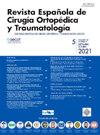接受全膝关节置换术的八旬患者能否恢复体力活动?
Q3 Medicine
Revista Espanola de Cirugia Ortopedica y Traumatologia
Pub Date : 2025-07-01
DOI:10.1016/j.recot.2024.07.018
引用次数: 0
摘要
背景和目的:有研究表明,全膝关节置换术可提高功能能力和体力活动;但年龄的影响仍不明确。本研究旨在通过膝关节社会评分(KSS)和 Tegner 评分来评估术前和术后的体力活动:我院对 2016 年 1 月至 2019 年 12 月间接受全膝关节置换术(TKR)的患者进行了回顾性队列分析。收集了人口统计学变量(年龄、性别和体重指数)、日常生活活动、年龄调整后的夏尔森合并症指数、美国麻醉医师协会评分、膝关节社会评分(KSS)的临床(KSSc)和功能(KSSf)分量表、Tegner功能量表、2011版KSS的活动变量以及使用视觉模拟量表进行的疼痛评估。分析了两个年龄组在这些变量上的差异:结果:共有 450 名患者接受了评估(A 组 245 人,B 组 167 人)。A 组的 Tegner 改善率为 1.19(95% CI 1.06/1.31),而 B 组平均为 0.61(95% CI 0.43/0.80)(P80 是 Tegner 改善率较低的独立风险因素)。在 KSSc 方面,A 组提高了 43 分(95% CI 40.82/46.14),而 B 组提高了 53 分(95% CI 49.74/57.80)。经混杂因素调整后,年龄大于 80 岁者的 KSSc 改善幅度明显更高(12.8 分)。就 KSSf 而言,A 组提高了 33.91 分(95% CI 31.07/36.75),B 组提高了 15.57 分(95% CI 11.78/19.35)。在对混杂因素进行调整后,大于 80 岁的患者比结论中的患者改善得更少:接受 TKR 的患者在体能和功能活动参数方面都有所改善。虽然这些改善在整个人群中都能看到,但在 80 岁以下的患者中最为明显。本文章由计算机程序翻译,如有差异,请以英文原文为准。
¿Los pacientes octogenarios sometidos a reemplazo total de rodilla regresan a la actividad física?
Background and objectives
It has been shown that total knee replacement improves functional capacity and physical activity; however, the influence of age remains unclear. The objective is evaluate the pre and postoperative physical activity measured with the Knee Society Score (KSS) score and the Tegner score.
Materials and methods
A retrospective cohort analysis was conducted on patients who underwent total knee replacement (TKR) between January 2016 and December 2019 at our institution. Demographic variables (age, sex, and body mass index), activities of daily living, age-adjusted Charlson Comorbidity Index, American Society of Anesthesiologists score, the Knee Society Score (KSS) in its clinical (KSSc) and functional (KSSf) subscales, the Tegner functional scale, activity variables from the 2011 KSS version, and pain assessment using the visual analog scale were collected. Differences in these variables were analyzed between two age groups: group A (between 65 and 79 years old) and group B (80 years or older).
Results
A total of 450 patients were evaluated (group A = 245, group B = 167). Group A showed a Tegner improvement of 1.19 (95% CI: 1.06-1.31), whereas group B averaged 0.61 (95% CI: 0.43-0.80) (P<.001). Age >80 was an independent risk factor for less Tegner improvement. In KSSc, group A improved by 43 points (95% CI: 40.82-46.14), while group B showed a greater increase of 53 points (95% CI: 49.74-57.80). Adjusted for confounders, those >80 showed significantly higher KSSc improvement (12.8 points). For KSSf, group A improved by 33.91 points (95% CI: 31.07-36.75), and group B by 15.57 points (95% CI: 11.78-19.35). Adjusted for confounders, patients >80 had less improvement than those < 80 (19 points).
Conclusions
Patients who underwent TKR experienced improvements in physical and functional activity parameters. While these improvements were seen in the entire population, they were most notable in patients younger than 80 years.
求助全文
通过发布文献求助,成功后即可免费获取论文全文。
去求助
来源期刊

Revista Espanola de Cirugia Ortopedica y Traumatologia
Medicine-Surgery
CiteScore
1.10
自引率
0.00%
发文量
156
审稿时长
51 weeks
期刊介绍:
Es una magnífica revista para acceder a los mejores artículos de investigación en la especialidad y los casos clínicos de mayor interés. Además, es la Publicación Oficial de la Sociedad, y está incluida en prestigiosos índices de referencia en medicina.
 求助内容:
求助内容: 应助结果提醒方式:
应助结果提醒方式:


